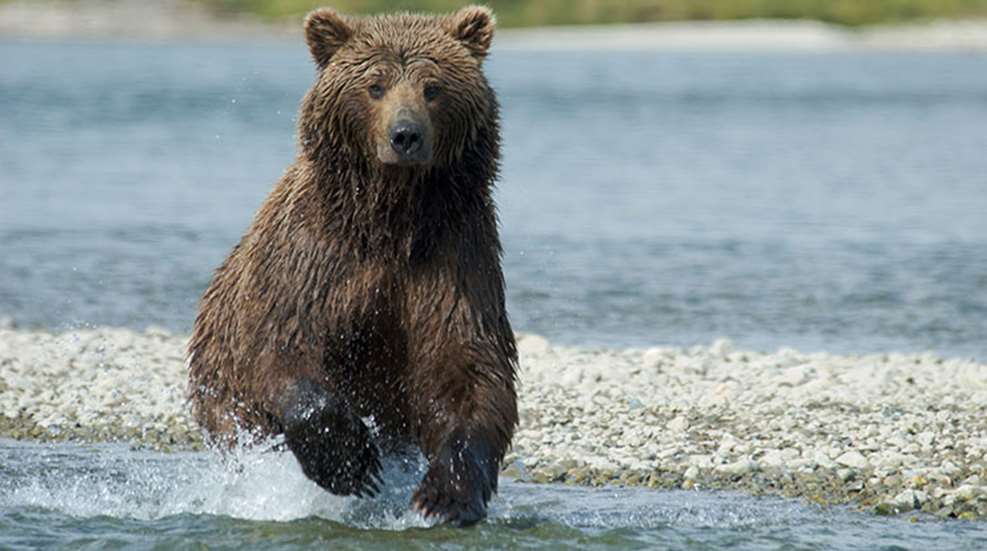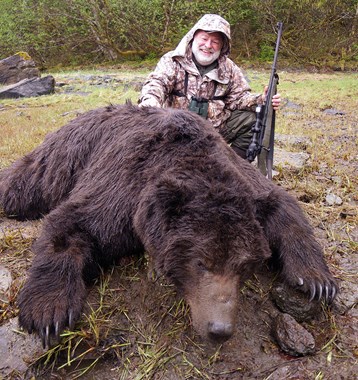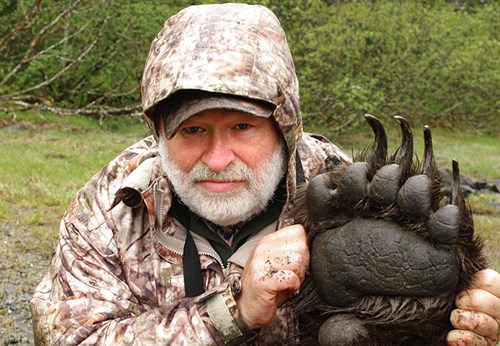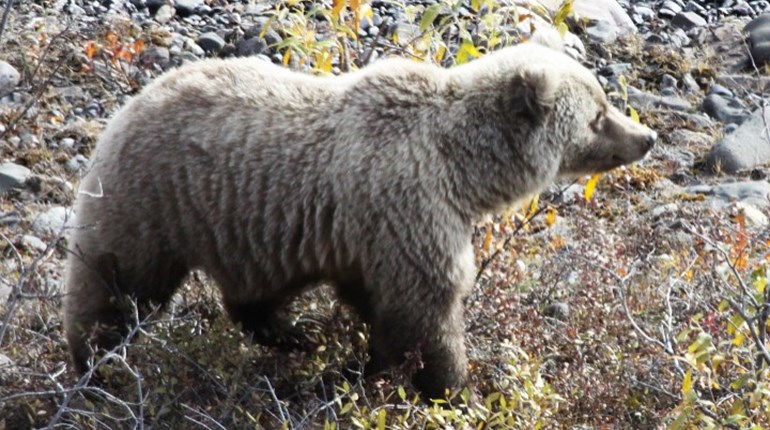
Whack him!
When I heard that, it was clear we had screwed up. We let this bear get too close and now he was coming for us on a dead run. The urgent voice behind me was spouting good advice, but I hesitated.
■■■
Chichagof Island, where I was hunting, is the fifth-largest island within the United States. It is the “C” of the ABC Islands of Southeast Alaska. The other two are Admiralty and Baranof. These islands are in the northern part of the Alexander Archipelago, which is all part of the Tongass National Forest.
We were several days into a spring brown bear hunt and I am not sure how many bears we had seen at this point, but it was a bunch. That included one large bear that came uncomfortably close, but never knew we were there. It was a good bear, but not quite good enough, so I never raised my gun. But I can tell you that an Alaska brown bear standing at spitting distance is an imposing presence. If your heart doesn’t pound, it’s not beating at all.
If I am counting right, this was my eighth hunting trip to Alaska and my fourth run at brown bears. The first two bear hunts were unmitigated disasters. The first disaster, my first time in Alaska, was due to an incompetent and crooked outfitter. The next brown bear hunt was mostly an exercise in watching the most extreme weather the Alaska Peninsula can produce. The third trip was a good hunt and resulted in a nice bear. This time, likely my last for brown bear, I wanted a great bear.
Which brings us back to the bear that was charging our position. He was a very good boar. He was probably just on the downside of 9 feet and considered a shooter under any other circumstance. But it was early in the hunt and he was not quite what I wanted.
We had been watching a female bear feeding on one of the tidal flats for nearly an hour. She had broken from cover on the far side of the opening, perhaps half a mile away, and was feeding along the river that bisected the tidal flat, sometimes disappearing down into the deep cut banks. Often she was out of sight for long periods of time, which made me wonder how often we glassed these flats, places you would think a rabbit couldn’t hide, but missed bears that were there.
She finally worked her way to our side of the clearing, perhaps 200 yards from us. That’s when a boar came out from the far end. He fed for a while, but then the wind shifted and he noticed this female. Spring is breeding season for bears and she clearly had made the right perfume choice. All of a sudden food was a secondary option for the boy bear. What he did after that would be called sexual harassment by today’s humans, but was just bear breeding behavior in Alaska. Actually, it’s a perspective thing. While she thought she was being harassed, from the male’s point of view she was being uncooperative. Regardless, she clearly was not ready for his attentions but he was not ready to go away.
We used the distraction to move in a little closer and finally wound up behind a huge boulder that was about 10 yards from the edge of the woods. Chris and I discussed the bear at length. It’s never an easy decision to pass on a trophy-size animal on any hunt and he was a for-sure “shooter.” Brown bears have haunted my dreams for most of my life, and he was a very good bear. It was an agonizing decision not to shoot, but as any hunter knows, if you settle, then it’s settled.
It wasn’t long before the female had enough of this guy and she ran into the thick woods to find some peace. The boar watched her go and then turned down a worn path that would send him past us close enough to smell his breath.
When the bear was 40 yards out Chris said, “We’d better let him know we are here.”
We stood up from behind the big rock as Chris slapped its top to get the bear’s attention before backing away behind me. The bear saw us and instantly broke into a run, straight for us.
That’s when Chris shouted, “Whack him!” The bear was only about 25 yards from us by then. I had the crosshairs on his chest, not wanting to shoot, but knowing that decision was about to be made for me.
I was perhaps a quarter of a second from shooting when Chris spoke and I saw something change with the bear. I let up on the trigger just a little, and waited.
In an after-action analysis, my guess was the bear saw the movement and thought we were the sow he had been chasing. I don’t think he wanted to eat us, but I do think he wanted to breed us. When Chris shouted the bear realized his mistake.
The boar stopped, way too close, looked at us for an exaggerated second and then let out a loud huff that sounded like, “Oh, man, I really screwed up that one” in bearspeak. Then he turned and ran into the woods.
If you truly love dangerous-game hunting, then you understand it is these moments that define everything.
■■■
The coastal Alaska brown bear was once thought to be a separate species from the interior grizzly, but today scientists say they are the same species: Ursus arctos horribilis, which is a name I love. When you hear “horribilis,” how can you think of anything but monsters?
The difference between a grizzly and a brown bear is one of geography. The brown bear lives in coastal areas where it eats well and has evolved into a larger bear than the interior grizzly, which lives a more hardscrabble life. In fact, it’s said that the brown bear rivals the polar bear as largest of the world’s bears. These bears are the largest land carnivores and collectively are North America’s only true dangerous game.
Brown bears live along the entire southwestern coast of Alaska, including the Alaska Peninsula, and can weigh up to 1,600 pounds. Typically, though, a big male will weigh 1,000 to 1,200 pounds, which is still a lot of bear.
The bears I was hunting on this trip may well be the most unique of the brown bears. While southeast Alaska bears actually tend on average to be the smallest of the Alaska brown bears, what makes “my bears” unique is that researchers discovered the bears on these islands are more closely related to polar bears than they are to other brown bears. They may even prove one day that polar bears descended from these brown bears.
Gerald Shields and Sandra Talbot of the University of Alaska-Fairbanks Institute of Arctic Biology began analyzing the DNA of brown bears from around the world. They discovered that the DNA from the ABC Islands brown bears was unique when compared to brown bears anywhere else on the planet. They found that the closest relative is the polar bear.
With this DNA evidence, Shields and his colleagues have launched a new hypothesis: Polar bears may have descended from brown bears. Studies continue to see if the polar bear is the offspring of the brown bear or if the two species mingled in their distant past, which would also explain the ABC Islands bears’ unique genetic fingerprint. Either way, these bears have been isolated from the mainland since the last ice age about 15,000 years ago and are a unique subspecies of the brown bear.

■■■
I have to add that hunting them is also a very unique adventure, one I would repeat in a heartbeat. Chris Erickson was the owner of Tok River Outfitters and is a lifetime Alaskan, born while Alaska was still a territory of the United States. He is 59 years old and has been guiding in Alaska all of his adult life, first as a guide for his dad, John Erickson, then as a partner and later as the sole owner of Tok River Outfitters. Although neither of us knew it at the time, this was his last spring brown bear hunt. A few months later somebody made him an offer he couldn’t refuse and he sold his operation. I gotta say, he ended things well.
Somebody called boat-based hunts “the civilized way to chase brown bears,” and having done it several other ways I will never argue against that point of view. We traveled and lived on the 45-foot Icy Lady. (Chris insists the boat is not named for his ex-wife, but I heard otherwise.) It can get crowded with four guys on a small boat, and I am the first to admit that I am an over-packing, too-much-gear slob. Chris, on the other hand, is a minimalist neat-freak who believes that everything has a place and should be in that place. We jokingly bickered like Oscar and Felix the entire trip, but it all balanced out nicely. We got along great and parted as friends.
Lucas Clark, head guide, is Chris’ partner and an exceptional hunter and woodsman. He is also extremely good-natured and a pleasure to be around. In my experience this combination, while documented to occur among hunting guides in their natural habitat, is very rare.
The fourth member of our party was Randy Fehr. Randy and his family have a huge dairy operation in Minnesota. I forgot the exact number, but I think he said they milk about a billion cows every day. The saying “beware the man with one gun” applies well to him as he uses the same .30-378 Weatherby for all his hunts. He is not a gun guy and because of that, I felt sorry for him.
You see, it turns out Lucas and Chris are both hard-core gun nuts. I mean the build-your-own-rifles, reload-your-ammo and experiment-with-wildcat-cartridges type of gun nuts. In other words, my kind of people. My friend the great outdoor humorist Pat McManus once wrote that he knew a gun writer who was so advanced in his profession that he no longer used letters or words in his writing about guns, just numbers and decimal points. That kind of describes our conversations on that boat.
More than once we would be deep into a technical discussion about some obscure point on ballistic coefficient or progressive propellant burning rates, and somebody would notice that Randy’s eyes had glazed over as he was approaching a catatonic state. Once in a while he would weakly mumble something about football, but we would not be distracted. Maybe a little of it rubbed off, because six months later Randy emailed to ask who I would recommend to build a new custom rifle for him. Welcome home, Randy, welcome home.
In coastal Alaska, it rains. Or at least that has been my experience. I once had a 28-day streak, over three Alaska hunts, when it rained every single day. I thought perhaps a spring hunt would change that. But I thought wrong, as usual. Lucas said that before I showed up it hadn’t rained for weeks and they were worried about drought. Fear not, droughts are my specialty. If you have one, invite me hunting, for I am The Rainmaker. On this 12-day hunt, it rained on 10 days.
One of those days Chris and I were working our way along a long slough, trying to see through the late-afternoon fog and rain when we spotted a huge bear feeding away from us. There was no way to approach him, so we turned right and climbed a ridge that formed a long, tree-covered peninsula along this open marshy land. We scrambled down the other side and then used the ridge as cover as we hurried to the end. We peered around to where the bear was when we last saw him, but he was gone. We climbed up on the end of the ridge and sat for hours, but he never returned.
Finally, Chris stood up and motioned for me to follow him. We walked to the end of the open ground and there was the sea. I was puzzled, disoriented, until Chris explained that we were actually looking at Tenakee Inlet on the far side of the island and that our path had been along an ancient portage. Chris mentioned that the portage was featured in Louis L’Amour’s book Sitka. The hero, Jean LaBarge, and his band of adventurers were being pursued by the Russians and were trapped. They managed to escape by dragging their three-masted schooner across this portage. When I asked him if we could try it with the Icy Lady he called me a bad name.
Like I said, a boat-based hunt is perhaps the most civilized of brown bear hunts. You return at night to a warm, dry place to sleep rather than to a waterlogged tent. There is a galley to prepare hot food, as opposed to tasteless, homogenized, freeze-dried backpacker rations. The “camp” is mobile so you can easily move locations if the hunting is slow and, unlike with an airplane, you can hunt the day you move, or even hunt as you move. But the best thing about any boat-based hunt is the fresh crabs.
When I first talked to Chris he said, “I’ll get you a good bear.”
“I know that,” I said. “I checked you out. But what I want to know is if there will be any crabs to eat.” I made sure to tell him that I had done several other coastal hunts where they promised fresh crabs and never delivered.
“I will feed you crabs until you beg for mercy,” Chris replied.
He came pretty close to pulling it off; he just underestimated my appetite.
We bought fishing licenses and put out crab pots. Each day we would find a high spot where we could glass for bears and Lucas would boil Dungeness crabs on a small gas stove. If there is a heaven it has to include sitting in springtime Alaska, eating fresh crab dipped in melted butter and glassing for brown bears. I suppose it’s possible I could tire of that, but not in 12 days. Come on, let’s be realistic!
I don’t know how many bears we glassed or how many we stalked to within shooting distance, but it was a bunch. We saw bears almost every day and probably were close enough to shoot at one on at least half the days we hunted. Some days we got in on multiple bears. I wasn’t sure I wanted it to end. But, like all things, it did.
■■■
 Randy shot a bear and the next day we took him to Tenakee Springs to catch a float plane back to Juneau. Twice while motoring back, Chris stayed with the boat while Lucas and I jumped into a skiff and headed to shore to stalk a bear we had spotted. I trusted Lucas. I knew he was an excellent judge of brown bears. He knew what my goals were and had been working with me to try for the best bear we could find. One of those bears came close, but in the end I decided to pass. The other gave us the slip.
Randy shot a bear and the next day we took him to Tenakee Springs to catch a float plane back to Juneau. Twice while motoring back, Chris stayed with the boat while Lucas and I jumped into a skiff and headed to shore to stalk a bear we had spotted. I trusted Lucas. I knew he was an excellent judge of brown bears. He knew what my goals were and had been working with me to try for the best bear we could find. One of those bears came close, but in the end I decided to pass. The other gave us the slip.
The afternoon was growing old as we passed the same bay where Randy shot his bear the day before. In the spring at that latitude, twilight lasts for hours and it was getting hard to see deep into these bays. I don’t remember who spotted the bear, but I think it was Chris. We stopped the Icy Lady and glassed deep into the back side of the bay where a bear was feeding on the plants exposed by the low tide. We were running out of time, so Lucas and I jumped into a skiff and ran hard to the back side of the closest finger of land. From there we power-marched through the exposed seaweed for more than half a mile.
They call the stuff “pop weed.” It is a brown algae seaweed with the scientific name of Fucus vesiculosus. It has paired air bladders within the blades that “pop” when they are stepped on, making a sneaky approach a bit tough. Not only is it noisy, the stuff is slippery and tangles your feet at the same time. Walking on it tires your ankles and knees very quickly. Also called “bladder wrack,” it is said to have medicinal qualities, but at the moment I pretty much just hated it.
It was extremely still, and as we moved past the last of our cover we were still about 200 yards from the bear. We stopped to glass and Lucas said he could hear the bear ripping up the sea grass and chewing it. I knew that if he could hear the bear, the bear could hear us.
Finally I heard the words I had been longing to hear for 10 days: “I think this is a bear we should take.” He looked big to me, but I have been fooled before. Every other time Lucas let me make the decision to shoot or not shoot. This time it was different.
We tried to ease closer, but the bear was getting nervous. There was no wind and the light was low—two factors in our favor—but sound carries across those flats and I was sure he could hear us walking. We closed to about 175 yards, a long shot on a bear, but such distance is always a consideration when hunting on the tidal flats. I planned my equipment around that. I had an accurate Dakota rifle in .375 H&H, topped with a Swarovski scope. The Barnes Vor-Tx 300-grain TSX ammo in the rifle shot flat enough that I was very comfortable at such distance, even on dangerous game.
I tried several times to find a comfortable position but was never confident enough to take the shot. Then I spotted a rock that was about 18 inches high and about 30 yards from me. I moved to it as quietly as I could and settled in behind it, resting the rifle on my hat.
The light was leaving fast and the bear was perhaps 25 feet from some of the thickest coastal brush on earth. The last thing I wanted to do was track a wounded brown bear in fading light in a place where visibility is measured in inches.
I waited until he was broadside and shot to break both shoulders. At the shot, the bear dropped. I worked the bolt fast and before I was done he was up. I hit him again. Then twice more, shooting fast, hoping I could anchor him there. With the last shot he dropped. The gun held five rounds. I had shot four and held the last in reserve as I watched him through the scope, but it was over.
I reloaded and we approached. He looked small, as dead bears often do when you first walk up on them, and my stomach started to boil. Had we missed the call? Lucas wasn’t saying much, which I took as a bad sign.
I waited until I couldn’t stand it anymore then quietly said, “Tell me what we have here.” Lucas hesitated, and I was beginning to dread his answer.
He finally replied, “I think this might be the best bear we have ever taken. Let’s stretch him out and take a look.”
It turns out that stretching the bear took a lot of effort. He was huge and heavy. But the last spring brown bear taken with Tok River Outfitters was indeed their best one ever. That boar squared 9 feet,
9 inches. The skull measured 279/16 inches by the recording game warden. It was initially reported to be the fifth-largest bear ever taken in Southeast Alaska. But after being re-measured by Fish & Wildlife, the skull was recorded as 277/16, which makes it the eighth-largest of all time from Southeast Alaska.
I can live with that. I am mostly about the adventure. It’s the hunt and the experience that counts most, not the inches of trophy. But when it’s one hell of an adventure and one hell of a bear, I am a happy man.





































